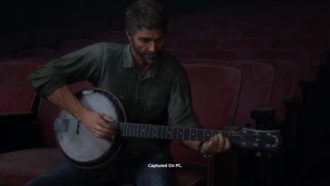Sony Interactive Entertainment, in collaboration with Nixxes Software and Iron Galaxy Studios, has brought Naughty Dog’s The Last of Us Part II Remastered to PC. The Last of Us Part II is perhaps the most quintessential video game of all time. And it is a story I firmly believe that every person should experience at least once throughout their life. A statement shared by us here at Checkpoint Gaming, who gave the original release on the PlayStation 4 a 10/10 and the remaster for PlayStation 5 a 9.5.
Whilst the absolute best features of the game remain the same — acting, story, sound design, gameplay, and accessibility options — the remastered port offers a myriad of technical issues and difficulties with optimisation. Problems that have not only been present in Sony’s recent attempts to port their games onto PC but are the same issues that plagued The Last of Us Part I.
Before we engage with the game’s immediate issues, let’s look at what this port does right. The Last of Us Part II Remastered on PC enhances the look and feel of the original game while also including new exclusive features. Improved graphics and refinements to fidelity bring this horrifyingly beautiful world to life in all its haunting glory.
Additionally, this remaster fully supports NVIDIA DLSS 3, AMD FSR 3.1, AMD FSR 4.0, and Intel drivers, as well as graphic settings that are fully customisable and established presets that range from very low to very high that allow for both low-end and high-end PCs to run this game. Support has also been added for widescreen and ultrawide monitors, as well as 4K resolution on compatible displays.
With these additions, The Last of Us Part II Remastered on PC looks just as visually outstanding as its console counterparts, and there are plenty of moments in this port where the environments look so incredible that I find myself sitting there, stuck in awe. The game’s cinematics are not only gorgeous but also perform exceptionally well, maintaining a consistent framerate and successfully running above 60fps while operating on an RTX 3060 with the medium graphical preset and DLSS turned on to balanced. In high-intensity gameplay sections, such as the spore-infested Subway or the Hospital Basement, where I expected performance to slow to a halt, I was pleasantly surprised that I was able to maintain a frame rate above 60.
You can play The Last of Us Part II Remastered on PC on a mouse and keyboard or by using a gamepad, with both options having full functionality and button mapping options. There is also a slew of accessibility features present, including Descriptive Audio and Speech to Vibration options.
This version of the game also offers the same features as the PS5’s remaster, including Lost Levels, Guitar Free Play, Speedrun Mode, developer commentary tracks, and the fan-favourite No Return, a highly addictive roguelike survival mode where players run through a series of randomised encounters, unlocking weapons, items, and abilities as they progress through a run, and eventually culminating in unlocking new playable characters. As part of this port, No Return will include two new characters, Bill and Marlene. As well as four new maps: Overlook, Nest, Streets, and the School.
Now, I want to address some of the remaster’s biggest issues. Firstly, while the various graphic options are great, the lack of any benchmarking tools frequently forces the player to take themselves out of the action to adjust the settings. In my first hour, I used the game’s opening cutscene to tinker with and modify various settings and values. Ultimately, I picked the medium graphics preset with DLSS on and set to balanced because it allowed me to actually get into the game. However, this changed several hours in as more and more issues became apparent.
“The game’s more visually intense sections, arenas, and areas place a significant burden on the CPU.”
It’s worth noting that the Last of Us Part II Remastered for PC places a heavy load on the CPU. My CPU usage consistently stayed above 85% during gameplay, even with nothing open in the background. The game’s more visually intense sections, people-dense arenas, and open-world areas like Jackson, Downtown Seattle, the WLF Stadium and Base, the Seraphite Island, and the entirety of Santa Barbara place a significant burden on the CPU.
As a result of the game demanding so much from the CPU, it continuously froze, hitched, stuttered, and on multiple occasions, it crashed on me. Changing any of my settings did nothing to resolve the issue, and I simply had to persevere through the headache-inducing stuttering and crash after crash. Furthermore, as a result of the CPU load, I also found that my frame rate would routinely seesaw between highs of 90 and absolute lows of 30. I have experienced no greater frustration when playing The Last of Us Part II than when I was in the game’s final confrontation between its two protagonists, bawling my eyes out and feeling sick to my stomach, only for the game to falter and crash on me. Tears were still rolling down my face as I realised that I would need to play one of the most harrowing sections from the beginning.

There are also bizarre-looking textures, strange reflections, and recurring glitches that show that this game is not as optimised for PC as it might suggest. I frequently noticed strange visual effects while playing with the medium graphical preset with upscaling turned on. These technical issues persisted even after I completely turned off upscaling following Ellie’s portion in Seattle. Moiré patterns and flickering appeared on both clothing and water textures, hair on character models splintered off into opposite ends of the screen, and in the game’s final act, I noticed that the reflection of sweat on models created a horrifically ugly and glossy smoothness on faces and blotchy and mumpy texture on hands and shoulders. Everything after Seattle made me feel like I was looking at a Barbie Doll that someone had left out in the sun.
“There is a clear discrepancy between how the game plays on mouse and keyboard versus playing on a controller.“
I also noticed a clear discrepancy between how the game plays on mouse and keyboard versus playing on a controller. I found that there were significant input delays when switching from a standing position to crouching and then going prone whilst using a mouse and keyboard. In addition to this, the camera was so horrifically sensitive that it made aiming almost impossible, and the inability to make precise movements, combined with a confusing default control layout, made playing with a keyboard and mouse feel counterintuitive at every moment.
Playing the game is a significantly smoother experience on a gamepad, especially on a PlayStation Dualsense controller. That’s where haptic feedback and adaptive triggers accentuate the tension felt in combat and the terror of running from a horde of infected, whilst also enabling players to execute movements and actions with precision, comfort, and ease.
Lastly, the game is also massive, taking over several hours to install. At just over 122 GB, it is also an essential requirement that you install it on your SSD. However, even on an SSD, I noticed irritatingly long loading times whilst the game compiled shaders and a high frequency in which assets, characters, and even enemies would pop into the world late. Sometimes, the enemies were still missing arms, legs, heads, or even their chest, and at worst, they continued to clip in and out of existence for the remainder of the encounter. But I only ever noticed that happening with the infected and never any of the human enemies.
Because load times were so long and always carried the chance that things would be missing, in any of the more difficult stealth and action sections, such as the Hillcrest suburbs, the holdout with the infected in the night phase of Abby’s Day 1 Seattle, or the Santa Barbara Resort, reloading after dying ended up feeling like a punishment more so than a chance to learn from my mistakes. This added to an already high level of frustration and indignation I had whilst playing.

The Last of Us Part II is by far one of my favourite games of all time. Naughty Dog created an astounding story that shattered technical limitations, deservedly won over 300 awards, and rightfully took the coveted Game of the Year trophy at the 2020 Game Awards. The game currently sits at 95% on OpenCritic, and while it has had its share of controversies and development issues, the final product is phenomenal.
Yet, that same praise should not be sung for The Last of Us Part II Remastered for PC. And whilst I am hopeful that patches and fixes will rectify many of the issues present — and the many I am sure are to be reported that I never experienced — I am still all the more disappointed and dissatisfied to see how The Last of Us Part II has fallen prey to Sony’s poor track record as of late when it comes to PC ports.











